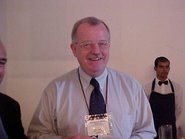Improving community resilience through nature
based solutions in Kenya
Boka –
situated in the North Eastern region of Keya - in our grandmothers time
provided the only water resource for all pastoralist communities in a vast
dryland area of over 200 km2. The Boka wells and rainy seasons offered enough
water for people and cattle and there were no conflicts of any significance.
Problems that did surface were dealt with by the council of elders.
After
independence a disconnect developed between the new legal systems governing water, land management, other
jurisdictions and the old traditional system of the council of elders dealing
with these issues. Population was growing, so were the numbers of livestock.
Climate change caused an increasing numbers of droughts which caused water scarcity
and conflicts over access to water.
These conflicts
often came to a climax of serious fights over who can feed his animals first and
there is no family that has no history of family members being killed or
severly wounded in such fights. These desperate situations led to attention of
donors and investments of them in water management and related themes in the
area. IUCN put in place a series of interventions that repaired the disconnect
between the old and new water governance systems by helping local authorities
and communities formulate Bylaws that regulate access and use of water. IUCN
also put Infrastructure in place to channel water from the river in the rainy
season into the wells and keep them better fed than before. This all being
accompanied by a series of capacity development and awareness raising activities.
Now the
settled and pastoral communities in Boka can use the water resources for both
human consumption and for livestock in a an organized way and satisfying all
basic needs again. Any conflict is solved through dialogue and other measures
foreseen in the Bylaws. The water conflicts out of the way means a huge
positive change for the communities as far as health is concerned, family
income, education for children and peace in the communities. More investment in
water management infrastructure and local capacity development will offer even
more opportunities for communities to cope with the effects of climate change
and increased droughts.
Improving community resilience through nature
based solutions in Uganda
Arwotngo –
situated in the Northern region of Uganda - in our grandmothers time was a
peaceful Parish, where people lived a simple but good life. They had ample
livestock and the fertile soil provided many opportunities for agriculture.
People were used to drinking milk and eating meat and vegetables. There was no
indiscriminate cutting of trees and when you needed one you went to your
grandfather to ask for permission. There were no conflicts of any significance.
Problems that did surface were dealt with by the council of elders.
In the
nineteen seventies things began to change. Tribes with weapons started to rob
us from our livestock. Women were raped. Children were abducted and never
returned. Then all out war started. There was little food. When the LRA entered
the stage things became even worse. In 2002 all people fled from the rural
areas to Lira, where we lived in refugee camps depended on International Relief
Aid. Outside the camps it was not safe. Inside we barely survived. In 2005
things began to improve and the first community members went back to their
homes. In 2008 the majority was back.
Life in the
camp was bad, but returning home was maybe worse. We had no international
support anymore, we had no housing, no food no nothing. So people started to
cut trees to cultivate crops and sell charcoal to the trucks that came from
Lira to collect the fuel. Wetland were turned into rice paddies. There was a
lot of domestic violence, we were constantly struggling for money. Water points
were shared between people and livestock, there was no sanitation causing a
range of health issues. Wetlands were drained and during droughts we had almost
no water and in the rainy season the rivers flooded our crops. Then IUCN came.
First we thought they were going to grab our land, as we were growing rice in
the wetlands. Later we realized they meant well with us as they gave us small
sums of money we could use to buy seedlings.
We
established a relationship of trust and they taught us saving, agro-forestry,
the use of fruit trees, e.g. the shea nut tree. They started conservation fund
from which we could borrow money to improve our income, on the condition that
we participated in their water management activities by demarcating riverbanks,
fencing water points, organizing ourselves to formulate by-laws etc. Very soon
we saw the positive results: more and better quality water, more income for
households, more peace at home, no more tree cutting, less floods. Now we have
a much more positive vision for the future and we feel we can cope better with
extreme droughts and floods.
Comparing the change strategies
In Kenya
the land and water management changes did not really affect business as usual
in the community. The men continued to be pastoralists, their women looked
after their families, they started jointly a garden to diversify their
livelihoods. The behavior change of community members was driven by the harsh experience
of two years of extreme drought: no water for people and cattle. The pain of
changing was far less than the pain of not changing. Improving and co-managing
the water resources, especially by integrating the traditional governance
systems was not a painful change. The only big change was the increased role of
women in managing the resources and the new phenomenon of girls going to school (a consequence of the new position of their mothers). A pain that men at last could deal
with.
In Uganda a
similar strategy to technically improve land and water management, diversify
livelihoods, strengthen self governance and learning did not work
automatically. People were not interested to participate in the IUCN project.
In the end they asked for a community revolving fund for small loans as a
condition to participate in the project. Here the pain of changing without the
fund would have been far bigger than the pain of not changing. Giving up their
charcoal burning and rice paddies without an alternative would mean no income.
In the camps they had learned to trade and set up small businesses, in the fund
they saw the opportunity to use these skills and have a source of income for
the short term. Fortunately IUCN was flexible enough to adapt their strategy. Then the change in the community started to develop along similar lines as in Kenya.
In both countries women were driven by values as self-direction (they saw the opportunity to become more independent) and security (they realized the importance of diversification of livelihoods). The men were driven by tradition (the by laws gave a new impetus to the traditional governance intstitutions such as the Council of Elders). These values proved stronger for both men and women than the values underpinning their behavior before the project came. For men driving values had been power (men are the owners of the cattle and that was more important for them than anything else) and hedonism (easy life). The behavior of the women was mostly driven by conformity (obedience). To upscale the project it is important to take into account the driving values of current and desired behavior.















